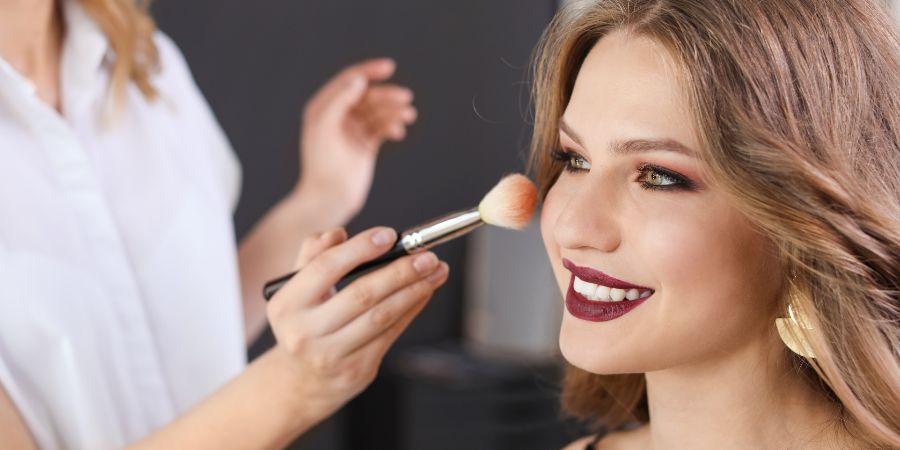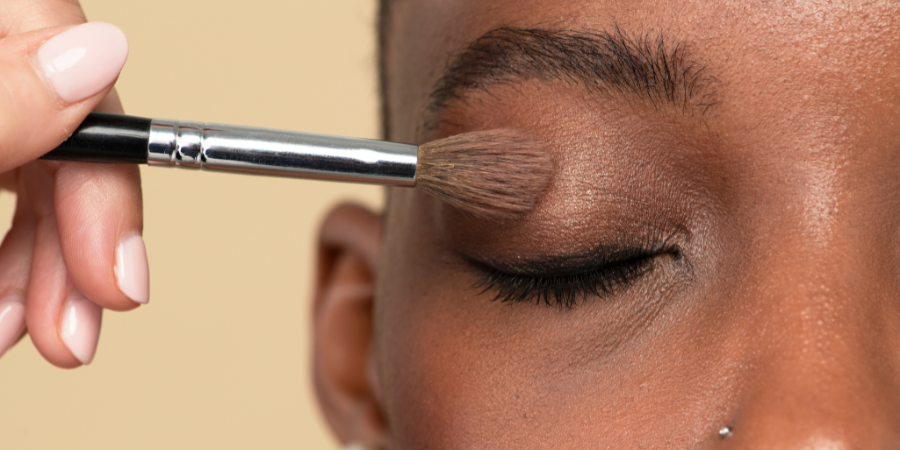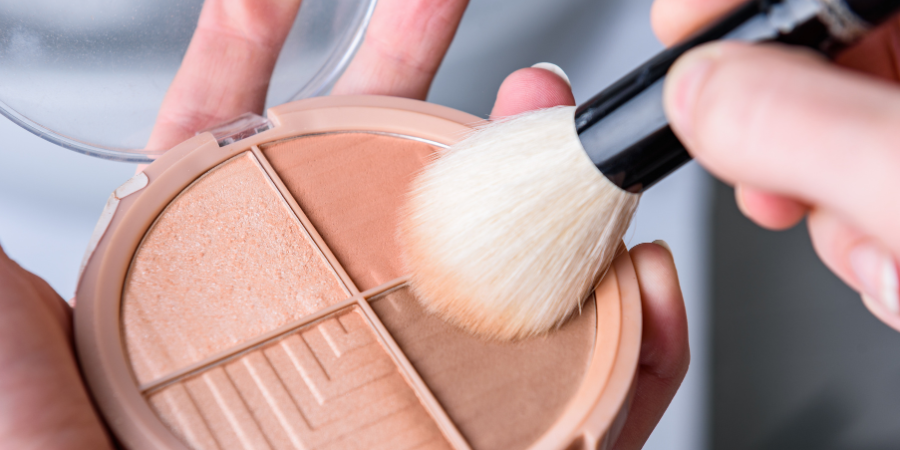Updated 2024
Every client is unique, with different skin types, tones, and face shapes that require tailored approaches in makeup application. Understanding these differences is key to being a successful makeup artist. However, to gain a strong understanding, you first need to learn makeup theory. The foundation of effective makeup artistry lies in selecting the right products that complement each individual’s unique characteristics.
In this article, we will explore:
- What is Makeup Theory?
- The Importance of Makeup Theory
- Undertones and Skin Types
- Enhancing Face Shapes
- Makeup Theory and Color Theory
- Frequently Asked Questions
Explore the exciting world of makeup theory with us and see how it can improve your skills as a makeup artist!

Makeup theory is easy to explain, but mastering it takes practice. Good makeup application works with your client’s skin to create a beautiful look. To make sure this look lasts, it’s important to choose the right products that highlight your client’s natural features.
Knowing how to build your makeup kit to match your client’s skin type is key, but understanding color theory is just as important. Knowing undertones helps you enhance your client’s beauty and add depth. You should assess skin tone and conditions before picking shades and colors.
When you learn the theory behind makeup, your skills improve, making clients happier. By understanding skin needs and differences, you can make your clients’ experiences much better than a regular makeup appointment.
The Importance of Makeup Theory
With makeup theory, you get to know color combinations and how to apply them. It’s this knowledge that sets a good makeup artist apart from the rest. There are many elements of makeup theory – things like color wheels, undertones, and skin types all play a part in creating the perfect look. Knowing how to blend these elements and apply them to your client’s face is what makes you a true artist.
Makeup theory also helps you understand the science behind makeup products. This knowledge gives you the ability to choose products that are suitable for different skin types, ensuring that they last longer and look better on your client. It also helps you create looks for specific occasions or events, such as bridal makeup or editorial shoots.
Makeup Theory: Undertones and Skin Types
The first step in makeup theory is identifying your client’s skin undertones. Undertones are the subtle hues that lie beneath the surface of the skin and determine how colors appear on different individuals.
There are three main types of undertones: cool, warm, and neutral. To determine your client’s undertone, look at the veins on their wrist or check if gold or silver jewelry looks better on them. This will help you choose the right foundation, concealer, and other makeup products that match their undertones.
Cool Undertones
Veins appear blue or purple, and silver jewelry looks more flattering.
Neutral Undertones
Veins appear a mix of blue and green, and both gold and silver jewelry look equally good.
Warm Undertones
Veins appear green or olive, and gold jewelry looks more flattering.
Along with undertones, understanding different skin types and which one your client has is also crucial. This knowledge will guide you in selecting products that work best for their specific needs. For example, individuals with oily skin should use oil-free or matte foundations to control shine, while those with dry skin should opt for moisturizing foundations to add hydration. Sensitive skin requires gentler products without harsh chemicals or fragrances to prevent irritation.
Boost your skincare game! Enroll in a skincare consultant course to enhance your expertise and serve your clients even better.

Makeup Theory: Enhancing Face Shapes
Just like every person has unique features, they also have different face shapes that require specific makeup techniques to enhance their natural beauty. There are six main face shapes: round, oval, square, heart, triangle, and diamond.
Each face shape has its own characteristics that can be accentuated with the right makeup techniques. For example, those with round faces may want to use contouring to create more definition and structure, while individuals with oval faces should focus on highlighting their cheekbones to enhance their already balanced features. Learning how to contour different face shapes can seriously elevate your practice!
Understanding face shapes will also help you choose the most flattering eyeshadow placement and eyebrow shape for your clients. By mastering these techniques, you can transform your client’s appearance and give them a confidence boost like never before!
Makeup Theory and Color Theory
To be a great makeup artist, it’s important to know color theory. This helps you create beautiful looks that highlight a person’s natural beauty. Color theory explores how colors interact and bring out different emotions and moods. It includes concepts like the color wheel, complementary colors, and the effects of warm versus cool tones. Mastering these principles allows you to skillfully mix and match shades for bold or subtle appearances.
Understanding color theory not only elevates your artistry but also helps you cater to individual preferences and skin tones, making your work more impactful. Colors can enhance features or create illusions—for example, using a light concealer to highlight under the eyes or a darker shade to contour the cheekbones.
5 Color Theory Hacks for Makeup Artists
- Use complementary colors to create a bold contrast.
- Warm tones (like orange, red, and yellow) bring warmth and vibrancy, while cool tones (like blue, green, and purple) add depth and calmness.
- Consider skin tone when choosing eyeshadow shades for clients.
- Don’t be afraid to mix different shades to create custom colors.
- Always blend well for a seamless and natural finish.
Quick Tip: Use QC’s Color Cheat Sheet when figuring out which colors to use for your client.

Frequently Asked Questions
Do I need to know color theory to be a successful makeup artist?
While it’s not mandatory to have a deep understanding of color theory, being familiar with its principles can significantly elevate your skills. It helps you create flattering looks that enhance your clients’ natural beauty. Understanding color relationships is key, especially when selecting shades that complement various skin tones. For instance, knowing how to balance warm and cool undertones can make a noticeable difference in the overall appearance of your makeup application.
Can I use the same techniques for all face shapes?
No, each face shape requires specific techniques tailored to its unique structure. Contouring and highlighting techniques differ for round, oval, square, and heart-shaped faces. Mastering these techniques is crucial as it allows you to enhance your client’s unique features and create a harmonious look that suits them best.
How can understanding skin types help me as a makeup artist?
Knowing the various skin types—oily, dry, combination—empowers you to select the most suitable products for your clients. Additionally, understanding skin concerns such as sensitivity or acne can help you make informed choices that promote healthy skin while achieving beautiful results.
Can I mix cool and warm tones in one makeup look?
Absolutely! Mixing warm and cool tones can create a multidimensional, eye-catching effect that adds depth to your makeup look. This technique allows for creative expression and can result in striking contrasts that enhance features. Just be sure to blend well to achieve a cohesive finish; for example, applying a warm bronzer with a cool-toned blush can create a balanced and vibrant look. The key is to maintain harmony while exploring different combinations.
What are some essential tools every makeup artist should have?
Essential tools for your makeup kit include a variety of brushes, sponges, tweezers, and a comprehensive makeup kit. High-quality brushes are vital for achieving precision in application and blending, while sponges can help create a flawless finish. Tweezers are essential for precise brow shaping, and having a well-stocked makeup kit ensures you have the right products for any occasion. Investing in quality tools can significantly enhance your application techniques and the overall results you achieve for your clients.
How do I choose the right foundation shade for my clients?
Choosing the perfect foundation shade for your clients involves careful testing. The best practice is to apply the foundation on the jawline or wrist in natural light, allowing you to assess the match more accurately. It’s important to always consider the client’s undertone—whether warm, cool, or neutral—as this will guide you in selecting the shade that seamlessly blends with their skin. Additionally, don’t hesitate to mix foundations if necessary to achieve the ideal match, ensuring your clients leave feeling confident and beautiful.

Makeup theory is so much more important than a lot of people may think and it takes so much time to really memorise and learn everything to make you an amazing artist. You need to learn colour theory and how each colour blends together, skin tones and the different face and eye shapes. This can help you choose the perfect undertones in foundations, powders and eyeshadows too match their skin to make it look more natural or make the colours pop which you will only know this if you practice and learn all the theory that is in these courses
I’d love to learn all of this
With professional training, you absolutely CAN learn all of this! <3 Please feel free to check out everything you need to know about our internationally-leading Master Makeup Artistry Course, which teaches the fundamentals of makeup theory: https://www.qcmakeupacademy.com/online-makeup-courses/master-makeup-artistry/
If you have any questions about the course, or just wish to know more about QC Makeup Academy, feel free to contact us anytime here: https://www.qcmakeupacademy.com/about-qc/contact-us/
Thanks so much for reading and taking the time to comment, Jummai! xx
All the best,
The QC Team
I really enjoyed reading this article because it reinforces the idea that makeup application is NOT a one-size-fits-all type of thing. We all have different combinations of skin type, facial structure, eye shape, etc., and I think it’s really good to try and work with as many different clients as you can. I’m still fairly new and haven’t worked on many people, but I truly get why this is so important!
Thanks Katie for sharing!
Great insight, Jordan! 🙂 This is one of the biggest reasons why we try to iterate that proper makeup training is a whole different ballgame than learning from social media influencers, for example. It’s critical to understand the different skin types, facial structures, skin tones, ages, etc. that you’ll encounter in the working world, as no two clients will ever be the same. Proper makeup theory is a key foundation for any professional MUA’s skill-set and knowledge of the craft. We think it’s wonderful that you’re taking the time to learn all of this, so you can apply it to your own career endeavors in the future! xx
All the best,
The QC Team
Thanks so much for the article. I enjoyed every piece of it. With this knowledge I will be able to impact it on others.
That’s SO great to hear, Sandra. That makes our day! x
All the best,
The QC Team
I am really grateful to read this post about makeup training as it make easy for me to write blog on makeup training. I was looking for a good post of makeup training and here I found this post. It is so helpful to write blog on makeup training so that most people can learn. This post show how to use makeup, and tricks and I am happy to see your post. It would be great if you have add some of video so that people could learn from watching video. It was good post though and help me a lot for my post. Thank you for your post. Loved it!
Hi Rakesh,
Thanks so much for taking the time to not only read our article, but for leaving such a wonderful comment! x
If you’re interested in checking out some videos of making applications, tutorials, and learning theory, we welcome you to check out QC Makeup Academy on YouTube: https://www.youtube.com/user/QCMakeupAcademy
We hope this helps! x
All the best,
The QC Team